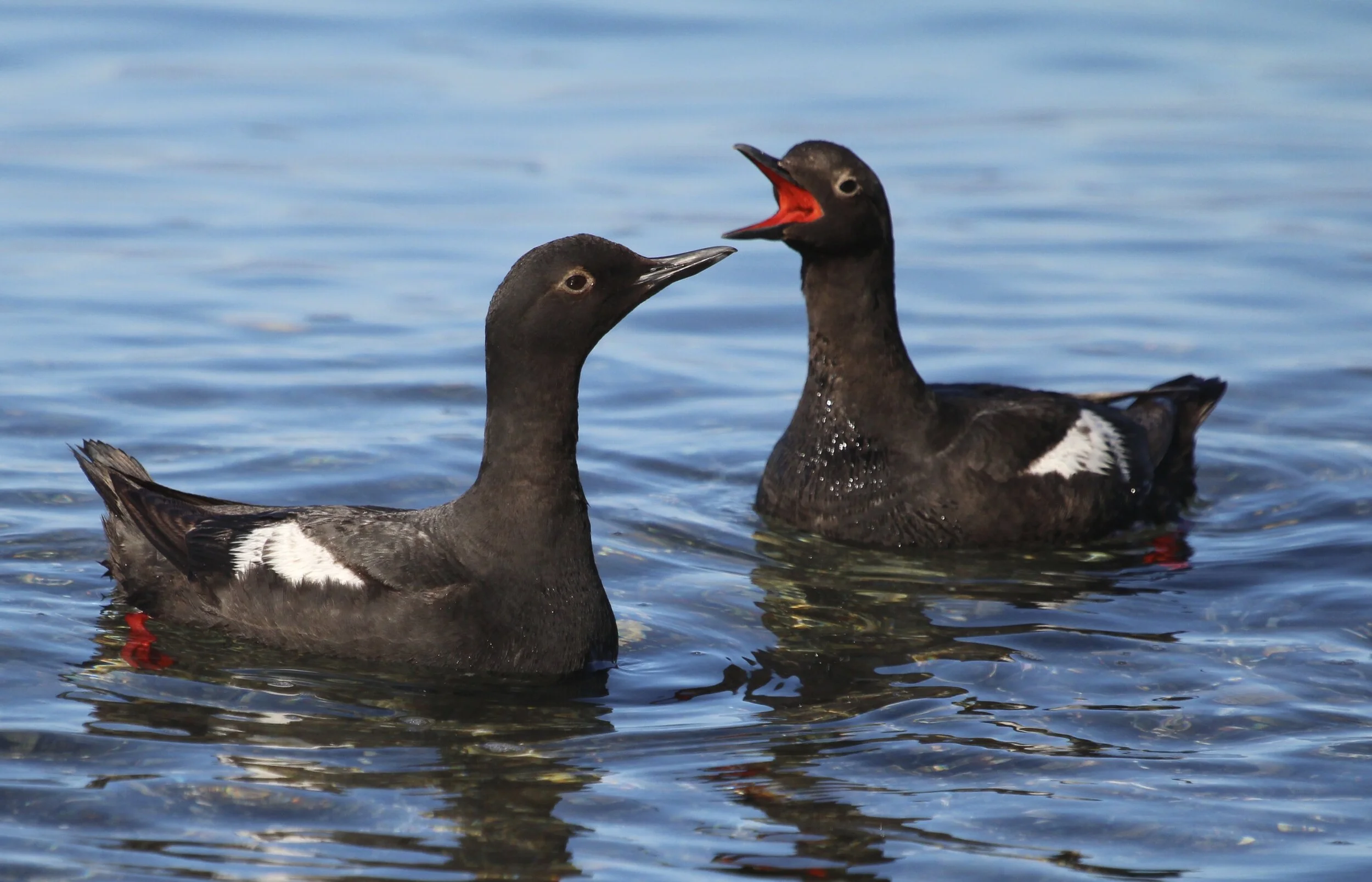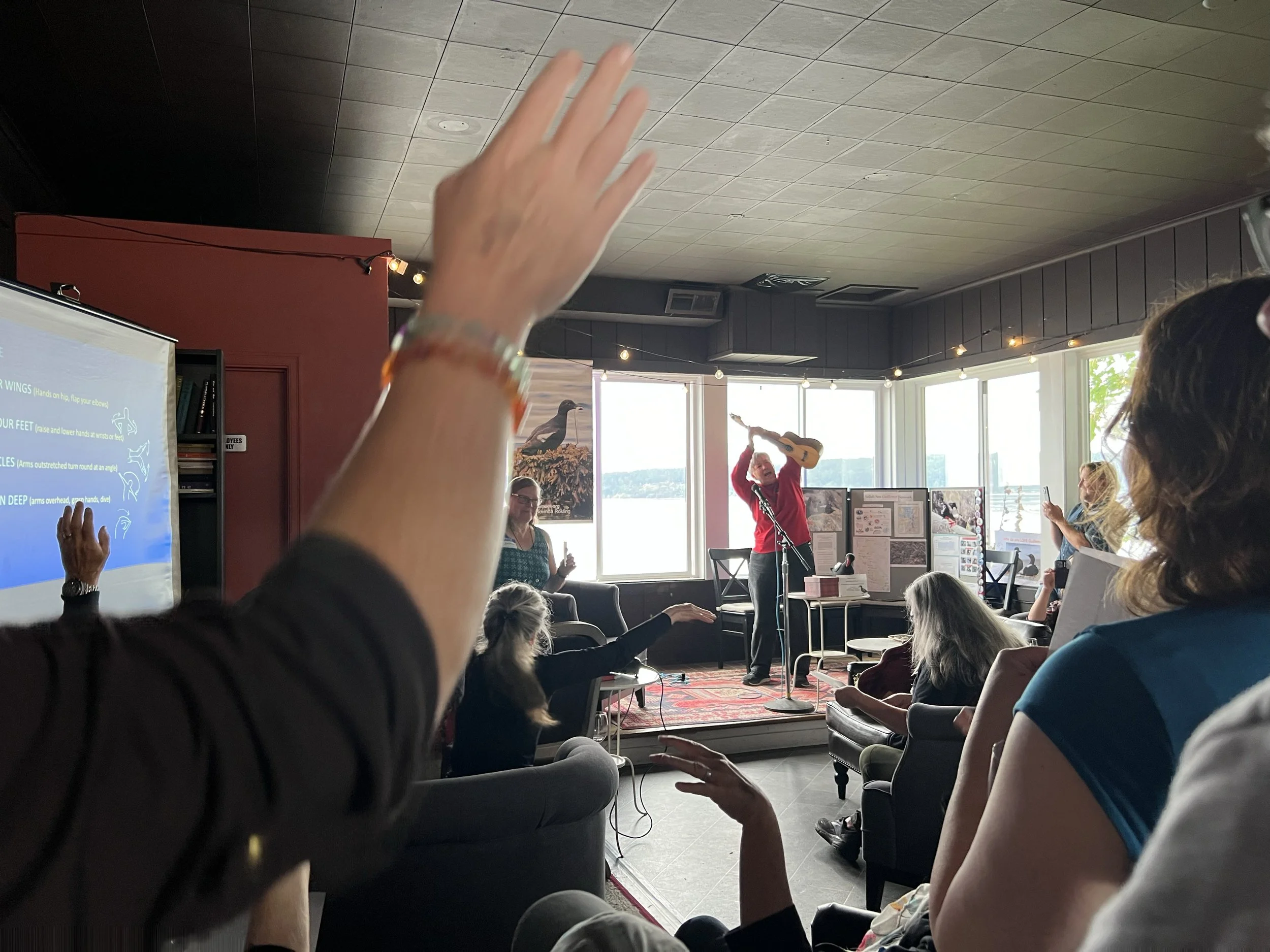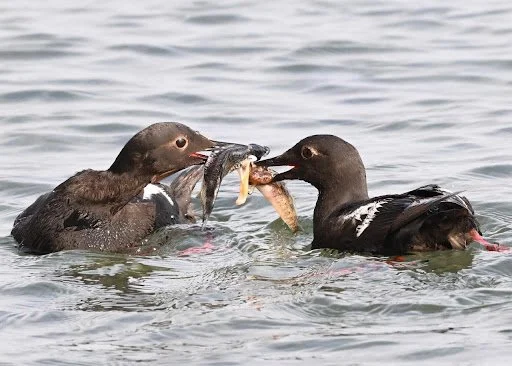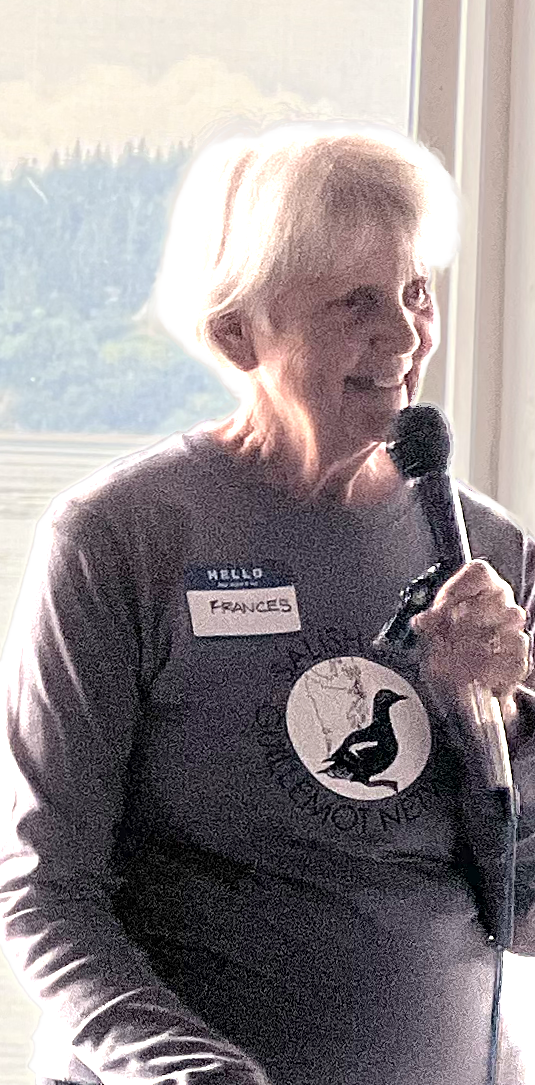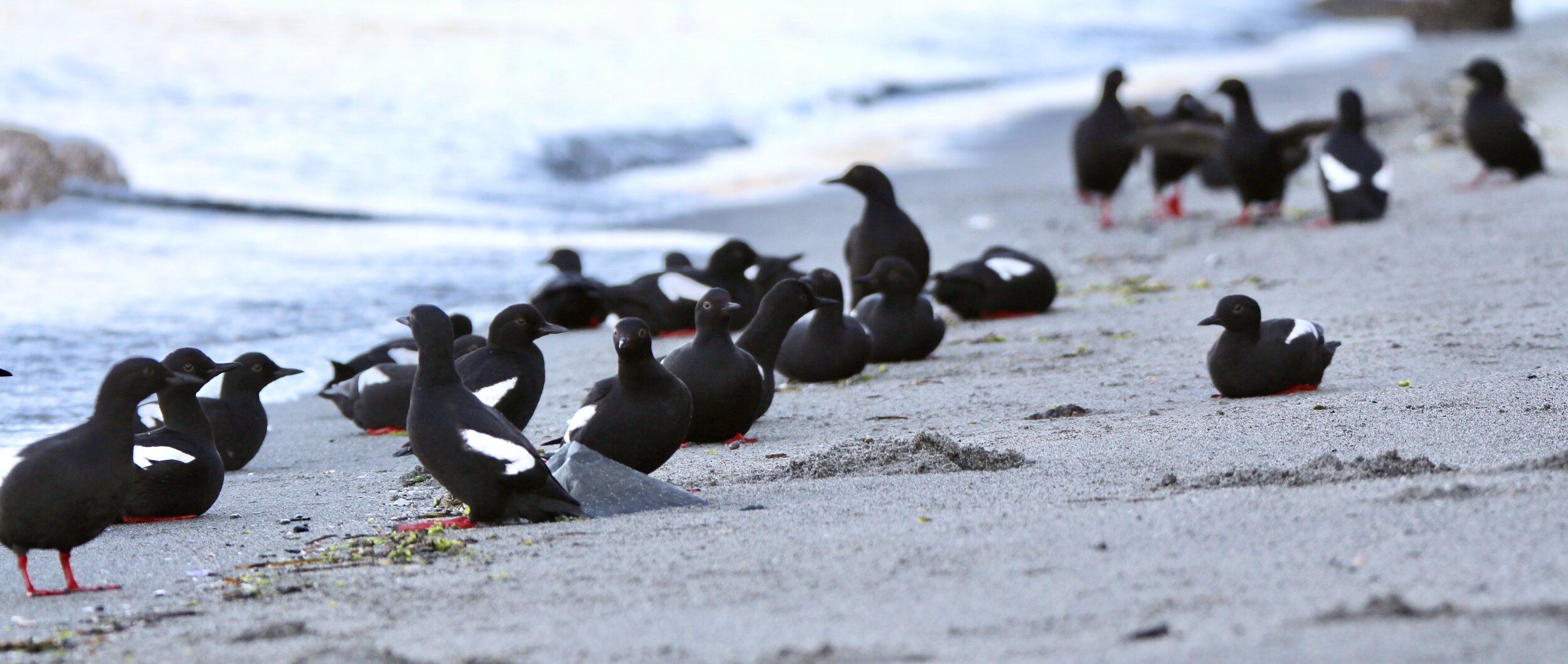
Pigeon Guillemot Breeding Survey
(Salish Sea Guillemot Network)
Learn more here!
The Salish Sea Guillemot Network is a community science project dedicated to the research, education, and protection of the Pigeon Guillemot in the Salish Sea. We monitor Pigeon Guillemot breeding colonies across the region to better understand their population dynamics and role in healthy coastal ecosystems.
We are a community science project started by Whidbey Audubon Society, dedicated to the education about and research and protection of the Pigeon Guillemot (Cepphus columba). Data collected by our survey is being used by University of Washington researchers, is recognized by the Puget Sound Ecosystem Monitoring Program (PSEMP) and is being integrated into the Washington Department of Fish and Wildlife marine bird database.
-
Pigeon Guillemots (PIGU) are endearing black and white seabirds with bright red mouths and feet. The Pigeon Guillemot is the only seabird that regularly nests on Whidbey Island. They typically nest in cavities (burrows) in the sandy bluffs that encircle much of Whidbey Island, though they are flexible. In the summer of 2021, a PIGU pair nested on the ramp counterbalance at the Coupeville Ferry Dock. A mated PIGU pair will normally have two chicks. Once a chick is fledged, it essentially tumbles from its burrow to the beach and then waddles to the water, where it will swim about and dive for fish until it is able to fly, approximately two weeks later.
-

Since 2004 community science volunteers have been monitoring the Pigeon Guillemot colonies on Whidbey Island during the breeding season, early June through early September. For one hour a week colony volunteers sit quietly on beaches around Whidbey Island and count the total number of PIGU, identify active burrows and the number of breeding birds and count the number and type of prey delivered by parents to their chicks.
-
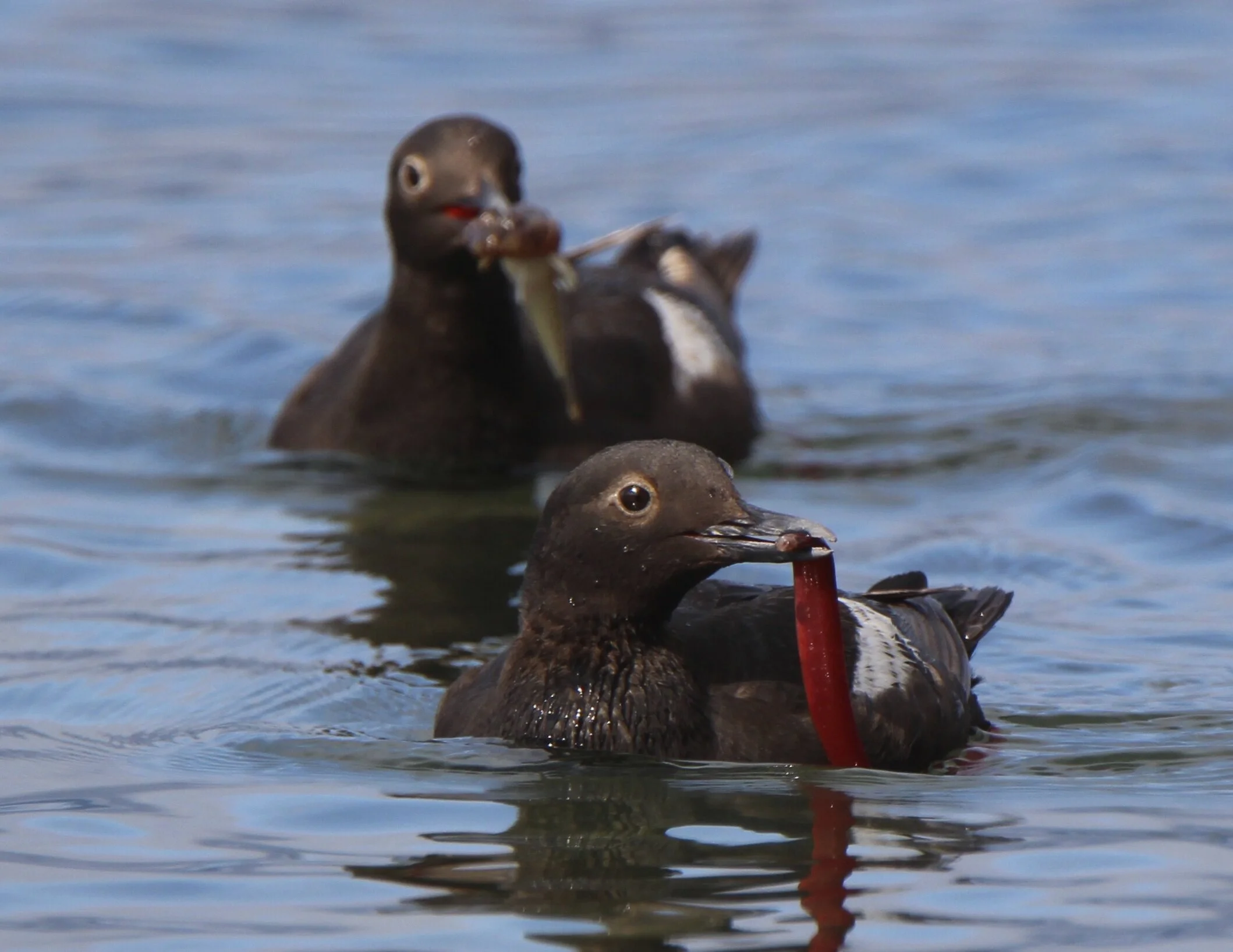
PIGU are an important indicator species of the health of the Salish Sea, in particular the health of the bottom dwelling fish that the PIGU favor. However, we also study these birds to help educate Island residents and others about the importance of bluff stewardship and the joy of having guillemots in our waters. Our dedicated group of community science volunteers spreads the word with their friends and neighbors as well as beach walkers.
Singing the “Pigeon, Pigeon, Pigeon Guillemot” song at the Guillemot Appreciation Celebration June 27.
2025 Pigeon Guillemot Survey season winding down
After approximately 10 weeks of monitoring Pigeon Guillemots, the season is slowing down. With fledglings in the water, many colonies have closed and others are nearing the end of the season. Many thanks to all our seasoned volunteers as well as the 23 newly trained volunteers.
Shannon Bolt, SSGN Program Coordinator, has worked all season to increase the volunteer’s skills in strategies to identify PGs in different stages of development and carry out the protocols for closing colonies at the end of the season. She is also refining the SSGN’s data sharing agreement as requests from outside organizations who want to use the SSGN data are increasing.
Pigeon Guillemot pair with prey.
Photo by Lac Pope
2025 Pigeon Guillemot Survey News: A Busy Summer!
By Ellen Nelson, WAS liaison to Salish Sea Guillemot Network
International Guillemot Appreciation Day
On June 27, we gathered at Ott & Hunter in Langley for this festive annual event. In addition to obtaining the legendary Guillemot tattoos, decorating red felt Guillemot feet, and designing Guillemot magnets, the many volunteers and friends present visited with fellow Guillemot aficionados and listened to an informal program:
Jenny Matsumoto’s presentation of what it’s like to be a surveyor of these comical, unpredictable, endearing marine birds had everyone laughing in recollection.
Dr. Sarah Converse from the University of Washington School of Aquatic and Fishery Sciences and School of Environmental and Forest Sciences conveyed the validity of our volunteering and its impact. The graduate students at her Quantitative Conservation Lab use our data to predict population trends of species and find links to species demographics, such as survival year to year and reproductive success. Our observations of population counts, prey delivery types, and disturbances are important factors that feed into those models. Increasing environmental changes make our observational data especially vital.
Shannon Boldt, our coordinator of the Salish Sea Guillemot Network, shared her overview of the seven Guillemot survey regions belonging to the Network: South Sound, Vashon Island, Bainbridge Island/Kitsap, Clallam County, Jefferson County, Camano Island and, of course, Whidbey Island. Shannon announced that she has been communicating with Birds of Canada, British Columbia region representatives. Although still in the early stages, the talks indicate that they would like to pilot our survey model in a few Canadian locations next year.
Special guest Frances Wood shared the story of how the Whidbey Guillemot Survey began over 22 years ago when a woman living at the Mutiny Sands bluffs encouraged her to “come see these birds.” Frances could find no information on “these birds,” so she went to the next Whidbey Audubon Society meeting and asked if anyone wanted to study “these birds” with her. Dr. Phyllis Kind’s hand shot into the air. Frances and Phyllis began their Guillemot study, which was so new no one even seemed to know the Guillemots burrowed in the bluffs! To celebrate Frances and her legacy, the Whidbey Coordinators gave her a crystal token of appreciation with this inscription: “Thank you, Frances. Your inspiration for the Pigeon Guillemot Summer Breeding Survey endures.”
Join the end-of-season online celebration!
Wednesday, October 1, at 6:30 p.m. on Zoom! Included will be a new slideshow presentation of PIGU bluffs across the regions and 2025 survey memories.
Dave Krause will present the highly anticipated summary of our data for the season.
We will have presentations by special guests Erin Arzola-Davis and Dr. Sarah Converse. Erin is a student of Sarah’s at the University of Washington. She is also a previous intern and surveyor of PIGU in the South Sound! She’s been analyzing a piece of our data and will share her findings.
Sarah Converse will add the latest findings of her study of PIGUs on Protection Island.
Check the Salish Sea Guillemot Network website to get the Zoom link for the celebration.
Planning for next year
Thinking about applying to be a new volunteer for the 2026 season? Learn more on the Pigeon Guillemot survey website. Click the buttons to the right.
We have assisted other organizations in starting their own surveys using our protocol and contributing to our database. In 2020, with these organizations we established the Salish Sea Guillemot Network (SSGN), consisting of our Whidbey Island survey, one sponsored by the Nisqually Reach Nature Center which covers three counties in the South Sound, a survey sponsored by Olympic Peninsula Audubon Society and Clallam County Marine Resources Committee, a survey sponsored by Vashon-Maury Island Audubon Society and the Vashon Nature Center, a survey in Kitsap County sponsored by the Kitsap Audubon Society, and a survey on Camano Island supported by Sound Water Stewards of Island County. Our survey, under the SSGN, has now been extended to seven counties bordering the Salish Sea.
To learn more about our PIGU survey and to find out how you can become a part of this amazing and important work, visit the Salish Sea Guillemot Network website here.
This article explains how University of Washington researchers are using our Pigeon Guillemot survey data:
Community science effort helps UW researchers understand local seabird populations
Please help us continue our survey of Pigeon Guillemots. Our data helps Washington agencies assess the health of the Salish Sea. As our survey grows to encompass more areas of our Region, so do our costs to ensure we maintain scientific-level data collection.
Photos by Govinda Holtby.


